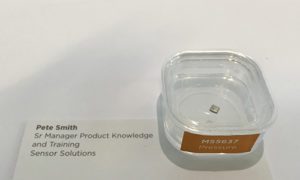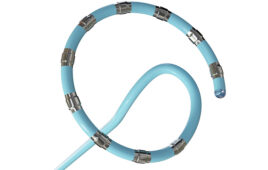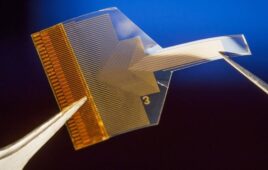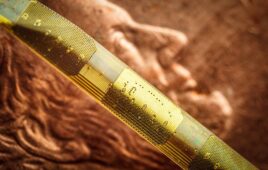
This altimeter sensor is 3-by-3-by-1 mm, and could go into a pendant for a fall alert device. [Photo by managing editor Chris Newmarker]
Sensor technology can help make up for the fact that the home, unlike a healthcare setting, doesn’t have well-trained staff available to operate equipment, said Pete Smith, TE Connectivity‘s senior manager of product knowledge and training for sensor solutions, during a Medical Design & Outsourcing interview last week.
“They have to redevelop the machines so they can take them home and they’re safe and effective and do what the patient needs,” said Smith, who was at MD&M West in Anaheim, Calif.
There are two main things that sensors can achieve in mobile health devices, according to Smith. Sensors can measure an array of vital signs including blood pressure, temperature, pulse oximetry and more. And just as important, they monitor the machine itself to make sure it is working properly.
“Say someone in the home knocks it down. When they pick it up, is it still working properly? … If there’s something wrong with the machine, it will report back on its own,” Smith said.
Here are four ways TE Connectivity (Schaffhausen, Switzerland) has sought to ensure that its sensors meet today’s mobile health challenges:
1. Sensors for harsh environments
TE has years of experience making sensors for applications such as oil and gas or marine environments that require the equipment to be rugged and tough. The company’s engineers, for example, know how to apply coatings to a sensor or package it in a waterproof enclosure, achieving IP ratings as high as 68 or 69, according to Smith.
Smith noted that the Brooklyn Bridge’s creators – John Augustus and Washington Augustus Roebling – engineered the bridge to be six times stronger than it needed to be. Thanks to the added safety margin, the Brooklyn Bridge is one of the few major 19th century bridges still standing today.
TE Connectivity incorporates the same type of safety margins into its sensors. If a sensor needs to be plus or minus 1% for a reading, for example, TE will make it plus or minus 0.5%. “That’s the thinking we do to make it happen,” Smith said.
2. Miniaturization
About 20 years ago, an insulin pump weighed 10 pounds and hung on a pole at the hospital. Now the pumps are about the size of smartphones. “Everything in the pump has to shrink, including the sensors,” Smith said. “There’s a huge effort toward miniaturization.”
Smith showed off an altimeter sensor that was 3-by-3-by-1 mm, and could go into a pendant for a fall alert device. TE is creating sensors that are as small as 2.5 mm across, Smith noted.
3. Power budget
Batteries, not sensors, are actually the major hurdle when it comes to miniaturizing mobile health devices, Smith said.
One thing TE Connectivity is able to do to help is to engineer sleep modes into its sensors. A pressure sensor, for example, might only sip 0.5 microamps while in sleep mode, cycling on 5 times a second to do a 10 microamp reading. The result is that other parts of the device such as the display or communications might use up power, but not the sensor. “We’re not part of the problem, which is a nice place to be.”
4. Multisensor modules
TE Connectivity has also been creating multisensor modules. For example, an altimeter, temperature sensor and humidity sensor might be packaged into one. Said Smith: “The advantage it provides is that instead of three packages on the circuit board, you have one.”
Medical customers, in fact, are paying a lot of attention to sensors – regularly inquiring about whether TE has a sensor that can fit a specific need, Smith said. “We’ll go back and ask, ‘Can we do that? Can we take some of our current technologies and morph them into something that they need?'”




